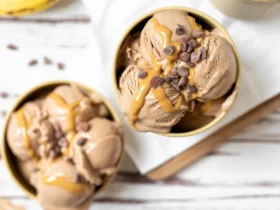You ever have a craving for something sweet, but also kinda chewy and satisfying? Not just sugary, but something with real texture that you can sink your teeth into.
I get that all the time. This recipe is my answer. We’re making Wingko Babat, a crazy good Indonesian coconut cake that’s sticky, sweet, and unbelievably easy. I’m going to walk you through it so you get it perfect the very first time.
This isn’t just a cake; it’s the perfect little snack with a cup of coffee. And your kitchen is going to smell amazing.
The Magic of Wingko Babat
So what even is this stuff? It’s a traditional Javanese cake made from just a few simple things: sticky rice flour, coconut, and sugar. That’s pretty much it.
The magic comes from how these things cook together. The glutinous rice flour gives it this amazing, addictive chewiness. The coconut gives it flavor and a little bit of bite. It’s all baked until the edges get golden brown and a little crispy.
It’s naturally gluten-free, which is a nice little bonus. It’s one of those recipes that feels special but is secretly simple. My favorite kind.
What You’ll Need
Getting your ingredients right is half the battle. Don’t just grab any old coconut off the shelf. The details matter here, trust me.
The star of the show is freshly grated coconut. It makes a world of difference. If you absolutely can’t find it, you can use frozen, but fresh is king. It has more moisture and flavor, which keeps the cake from getting dry.
Here’s the full list of what you’ll need to grab.
| Ingredient | Amount |
|---|---|
| Glutinous Rice Flour | 2½ cups (300g) |
| Granulated Sugar | 1 cup (200g) |
| Salt | 1 teaspoon |
| Grated Coconut (fresh or frozen, thawed) | 2½ cups (250g) |
| Thick Coconut Milk (canned is fine) | 1 cup (240ml) |
| Unsalted Butter (melted) | 2 tablespoons |
| Vanilla Extract | 1 teaspoon |
| Egg (for the egg wash) | 1 large |
The Right Tools for the Job
You don’t need a bunch of fancy kitchen gadgets for this one. A bowl, a pan, and an oven are pretty much all it takes.
Keeping it simple is the name of the game.
| Tool | Quantity |
|---|---|
| Large Mixing Bowl | 1 |
| 9-inch Round Cake Pan | 1 |
| Whisk or Spatula | 1 |
| Parchment Paper | Enough for pan |
| Small Bowl (for egg wash) | 1 |
| Pastry Brush | 1 |
Let’s Make Some Sticky Coconut Cake
Alright, this is the fun part. Just follow along, and you’ll be fine. I’ll keep it simple and tell you exactly what to look for.
Step 1: Get Your Oven and Pan Ready
First thing’s first, preheat your oven to 350°F (175°C). You always want your oven ready to go.
Next, grab your 9-inch round cake pan. Grease it with a little butter or oil, then line the bottom with parchment paper. This little step is a lifesaver. It guarantees your cake won’t stick, and cleanup will be way easier.
Step 2: Mix Your Dry Stuff
In your big mixing bowl, dump in the glutinous rice flour, granulated sugar, and salt.
Give it a good whisk. You want to mix it all together so there are no clumps. This makes sure every bite has the right balance of sweet and salty. It should look like fine, white sand when you’re done.
Step 3: Add the Coconut
Now, add your grated coconut to the bowl with the dry ingredients.
Use your hands for this part. It’s the best way. Mix the coconut into the flour and sugar until it’s all evenly spread out. You’re basically coating every little piece of coconut with the flour mixture.
Step 4: Pour in the Wet Ingredients
Okay, time for the wet stuff. Pour the thick coconut milk, melted butter, and vanilla extract into the bowl.
Switch to a spatula and start mixing. Scrape the bottom and sides of the bowl to make sure everything gets mixed in. The batter will be very thick and sticky, kind of like a very thick oatmeal. That’s exactly what you want. Don’t overmix it; just mix until you don’t see any more dry flour.
Step 5: Press it Into the Pan
Spoon the thick batter into your prepared cake pan.
It won’t pour in smoothly, so you’ll need to use your spatula (or wet hands) to press it down evenly. Try to get the top as flat as you can. This helps it bake evenly so you don’t get a gooey center and burnt edges.
Step 6: Time to Bake
Slide that pan into your preheated oven. Bake it for about 40-45 minutes.
You’re looking for the edges to start pulling away from the sides of the pan and turn a nice golden brown. The center should feel firm if you gently press on it. Don’t worry if it’s not super brown on top yet; we’ll fix that in the next step.
Step 7: The Egg Wash Secret
While the cake is baking, crack the egg into a small bowl and whisk it up. This is your egg wash.
After the 40-45 minutes are up, carefully pull the cake out of the oven. Use your pastry brush to brush a thin, even layer of the beaten egg all over the top. This little trick is what gives the cake that beautiful, shiny, golden-brown finish.
Step 8: The Final Bake
Put the cake back in the oven for another 10-15 minutes.
This final bake will cook the egg wash and give the top that perfect color. Keep an eye on it. You want it deeply golden, but not burnt. Once it looks amazing, take it out and let it cool in the pan for about 15 minutes.
Step 9: Cool and Slice
After 15 minutes, run a knife around the edge of the cake to loosen it. Carefully flip it out onto a wire rack, peel off the parchment paper, and let it cool completely.
This is the hardest part. You have to wait. If you slice it while it’s warm, it will be a gooey mess. Once it’s fully cooled, you can cut it into diamond shapes or squares.
Pro Tips From My Kitchen
I’ve made this cake more times than I can count, and I’ve made a few mistakes along the way. Here are a few things I learned so you don’t have to.
H3: Don’t Squeeze the Coconut
If you’re using fresh or frozen grated coconut, it has a lot of natural moisture. Do not, under any circumstances, squeeze that moisture out. That water is pure flavor, and it’s what keeps the cake from turning into a dry, hard brick. You want that moisture.
H3: The “Wet Hands” Trick
The batter is super sticky. Like, ridiculously sticky. When you’re pressing it into the pan, it can be a real pain. The easy solution? Slightly dampen your hands with water. The batter won’t stick to your wet hands, and you can press it into an even layer with no trouble at all.
H3: Let It Cool. No, Really.
I know I said this already, but it’s the most common mistake people make. The cake is still setting up as it cools down. If you cut into it while it’s hot, the starches in the rice flour haven’t had time to firm up. You’ll get a mushy texture. Be patient. Go make a cup of tea. It’s worth the wait.
H4: Use Full-Fat Coconut Milk
This is not the time to reach for the “lite” coconut milk. The fat content in full-fat coconut milk is essential for the rich flavor and tender texture of the cake. Using low-fat milk will make it less satisfying and can mess with the final texture.
Swaps and Fun Variations
Once you get the basic recipe down, you can start playing around with it. It’s a pretty forgiving cake.
Ingredient Substitutions
Here are a few common swaps you might need to make.
| Ingredient to Swap | Good Substitution | Notes |
|---|---|---|
| Granulated Sugar | Brown Sugar | Will give a deeper, caramel flavor |
| Vanilla Extract | Pandan Extract | Adds a classic Southeast Asian flavor |
| Unsalted Butter | Coconut Oil | Keeps it dairy-free and adds more coconut flavor |
Fun Flavor Ideas
- Pandan Power: Replace the vanilla extract with 1 teaspoon of pandan extract. It will turn the cake a light green and give it a wonderful, almost grassy-vanilla flavor.
- A Little Zest: Add the zest of one lime to the dry ingredients. The citrus cuts through the richness and adds a nice, fresh pop of flavor.
- Chocolate Chip Surprise: Mix in about ½ cup of mini chocolate chips into the batter before baking. Coconut and chocolate are always a good idea.
Making It Ahead and Storing Leftovers
This cake is great for making ahead of time. It actually tastes even better the next day, in my opinion.
Make-Ahead Tips
You can mix the entire batter, press it into the pan, cover it with plastic wrap, and store it in the fridge for up to 24 hours before baking. Just let it sit on the counter for about 30 minutes to come to room temperature before putting it in the oven.
Leftovers and Storage
Store any leftover cake in an airtight container at room temperature. It will stay fresh and chewy for about 3 days.
If you keep it any longer, the coconut can start to go bad. I wouldn’t recommend refrigerating it, as it can make the cake hard and dry.
You can also freeze it. Cut the cooled cake into individual slices, wrap each one tightly in plastic wrap, and then put them in a freezer bag. They’ll last for about a month. To eat, just let a slice thaw on the counter for an hour or so.
What’s the Nutritional Deal?
Look, this is a cake. It’s made of sugar and coconut. It’s a treat, not health food. But if you’re curious, here’s a rough idea.
Keep in mind this is just an estimate. The actual numbers will change based on the specific brands you use.
| Nutritional Info (per slice, 12 slices) | Approximate Amount |
|---|---|
| Calories | 250 kcal |
| Carbohydrates | 35g |
| Fat | 12g |
| Protein | 3g |
| Sugar | 20g |
Frequently Asked Questions
Here are some questions I get asked all the time about this recipe.
Q1. My cake came out really dry. What did I do wrong?
Ans: You probably used desiccated (dried) coconut instead of fresh or frozen. The lack of moisture in dried coconut will suck all the liquid out of the batter, making the cake dry.
Q2. Is glutinous rice flour the same as regular rice flour?
Ans: No, they are totally different. Glutinous rice flour (also called sweet rice flour or mochiko) is what gives the cake its signature chewy, sticky texture. Regular rice flour will just make it crumbly.
Q3. Can I use a different size pan?
Ans: You can, but you’ll have to adjust the baking time. A smaller pan will make a thicker cake that needs more time to bake, while a larger pan will make a thinner cake that bakes faster.
Q4. Why didn’t the top of my cake get brown and shiny?
Ans: You might have skipped the egg wash step. That’s the key to getting that beautiful, glossy finish on top.
Wrapping Up
There you have it. A simple, delicious, and wonderfully chewy coconut cake that’s pretty much guaranteed to make people happy.
It looks like it’s a lot of work, but now you know the secret. It’s just mixing a few things in a bowl and baking it. The oven does all the hard stuff.
So give it a try. I promise you’ll love it. When you make it, come back and leave a comment. Tell me how it went, if you tried any fun variations, or if you have any questions. I’d love to hear from you.






Leave a Reply